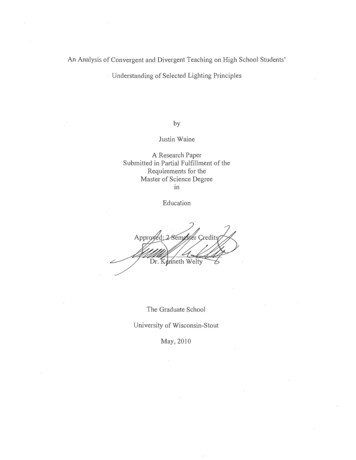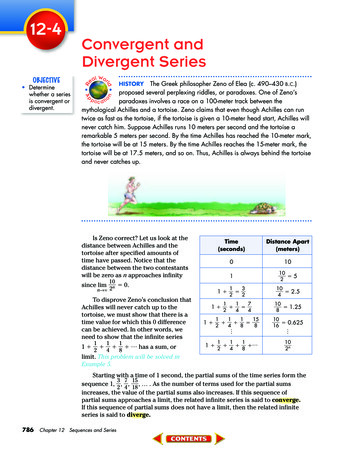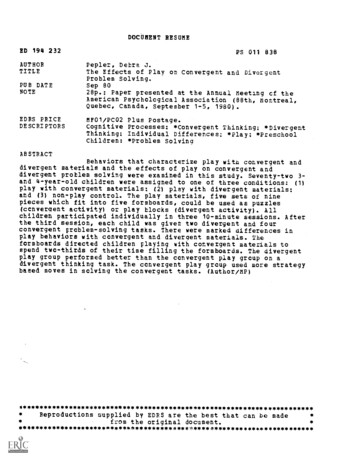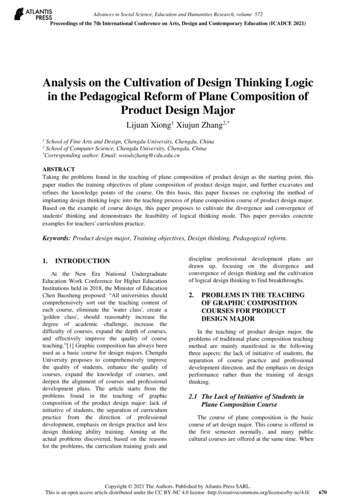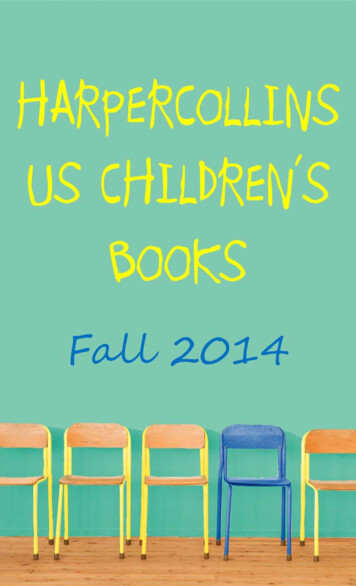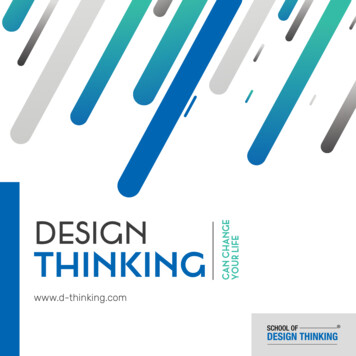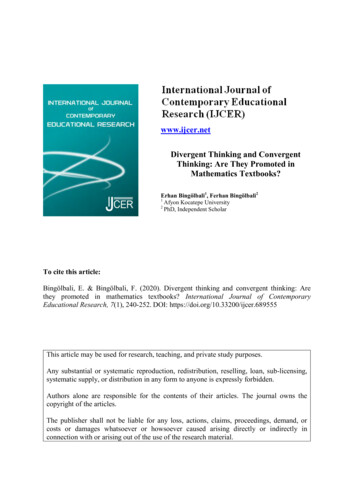
Transcription
www.ijcer.netDivergent Thinking and ConvergentThinking: Are They Promoted inMathematics Textbooks?Erhan Bingölbali1, Ferhan Bingölbali21Afyon Kocatepe University2PhD, Independent ScholarTo cite this article:Bingölbali, E. & Bingölbali, F. (2020). Divergent thinking and convergent thinking: Arethey promoted in mathematics textbooks? International Journal of ContemporaryEducational Research, 7(1), 240-252. DOI: https://doi.org/10.33200/ijcer.689555This article may be used for research, teaching, and private study purposes.Any substantial or systematic reproduction, redistribution, reselling, loan, sub-licensing,systematic supply, or distribution in any form to anyone is expressly forbidden.Authors alone are responsible for the contents of their articles. The journal owns thecopyright of the articles.The publisher shall not be liable for any loss, actions, claims, proceedings, demand, orcosts or damages whatsoever or howsoever caused arising directly or indirectly inconnection with or arising out of the use of the research material.
International Journal of Contemporary Educational ResearchVolume 7, Number 1, June 2020, 240-252ISSN: 2148-3868Divergent Thinking and Convergent Thinking: Are They Promoted inMathematics Textbooks?Erhan Bingölbali 1*, Ferhan Bingölbali 21Afyon Kocatepe University2PhD, Independent ScholarAbstractThis study explores whether mathematics tasks in primary school mathematics textbooks provide opportunitiesfor divergent and convergent thinking. Four mathematics textbooks (one from each of first to fourth grades) areexamined for this purpose. A task is divided into three segments for the analysis and the segments are named asthe beginning, the intermediary, and the end. These segments are analysed in terms of the numbers of entrypoints, solution methods, and correct outcomes respectively. The modes of the segments enable us to identifysix different tasks. Tasks that definitively have an open-ending (multiple correct outcomes) are considered tohave divergent thinking features and those which have only one correct outcome are deemed to have convergentthinking characteristics. The study reveals that the textbooks provide opportunities for both divergent andconvergent thinking, yet more chances are particularly given for convergent thinking. The findings are discussedin relation to divergent and convergent thinking alongside creativity and some implications are provided fortextbooks studies.Key words: Divergent thinking, Convergent thinking, Mathematics textbook analysis, Creativity, Open-endedtasksIntroductionDivergent thinking (DT) and convergent thinking (CT), which are often associated with creativity, are desirableskills for student learning in all disciplines including mathematics education. These two terms (together,separately or only DT) sometimes are used to describe creativity as creativity is also linked with “originalthought and divergence from the norm” (Bennevall, 2016, p. 1; Cropley, 2006). DT is generally associated withmultiple and alternatives outcomes while convergent one is linked with a single correct answer in responding toa posed question (Cropley, 2006). Alongside their descriptions and features, ideas about how to cultivate andfoster them in students have also drawn attention. One aspect that has drawn particular attention is the tasks andtheir features. Open-ended tasks are one such type that has received more attention.Given that cultivating and fostering DT and CT in students are closely related to tasks to which students areexposed, it is then important to examine school textbooks in terms of types of the tasks that they present. It is ofgreat importance to examine textbooks in this respect as the research shows that textbooks, their contents andtheir structures have influences on both student learning and teacher teaching (Valverde et al., 2002; Haggartyand Pepin, 2002; Eisenmann and Even, 2011; Olsher and Even, 2014). It appears, however, that an examinationof textbook tasks in terms of DT and CT has not been the focus of much research in mathematics education.With this gap in mind, this study sets out to examine the extent to which primary mathematics textbooks presenttasks with DT and CT features.After this brief introduction, this paper is structured as follows. First, literature review on DT and CT isprovided in connection with creativity. Then, DT and CT are examined in close relation with the task issue anda particular attention is paid to open-ended tasks. Afterwards, the theoretical framework of the study ispresented. Methodology, results, discussion, conclusions and educational implication sections follow thissection respectively.*Corresponding Author: Erhan Bingölbali, erhanbingolbali@yahoo.co.uk
IJCER (International Journal of Contemporary Educational Research)241Literature ReviewThis section presents features and definitions of DT and CT first and then provides a concise review on howthese two have been studied. They are particularly examined in connection with the research on the tasksstudies.DT and CT are considered to be the two key important cognitive processes for creative thinking and Joy PaulGuilford (1967) is often given credit for making distinction between these two processes (Japardi, Bookheimer,Knudsen, Ghahremani & Bilder, 2018). Based on the relevant literature, Japardi et al. (2018, p. 59) describe DTas “the ability to disengage from prevailing modes of thought and expression to generate novel ideas andsolutions” while CT as “the recruitment and interaction of different cognitive processes to find a commonsolution to a given problem.” Similar to the description of Japardi et al. (2018), Cropley (2006, p.391) definesDT as one “involves producing multiple or alternative answers from available information”. By the contrast, hedefines CT as being “oriented toward deriving the single best (or correct) answer to a clearly defined question”.Similar descriptions of DT and CT are put forward by many different researchers (e.g., Brophy, 2011; Kwon,Park and Park, 2006; Balka, 1974) and common to all is that DT is associated with variability and CT is linkedwith orthodoxy (Cropley, 2006).As far as research on DT and CT is concerned, it seems that they have mainly been researched in relation to theissues of creativity, personality traits, cognitive processes, mathematics learning performances, and tasks typesand features. First and most noticeably, creativity is the main factor that DT and CT have received a closeattention in research. Even though there are different views, it is mainly DT that is being associated withcreativity. For instance, based on a meta-analysis, Kim (2008) found that a significantly higher relationship doexist between creative achievement and DT test scores. Cropley (2006) approaches creative thinking in terms ofnovelty and associates DT with generation of the novelty while CT with the evaluation of the novelty. Heemphasizes the important role of CT and notes that without CT, DT may not be fruitful for the production ofeffective novelty.In terms of personality traits, the question of “Why do some people like to come up with multiple possibilities,whereas others stick to the first solution that comes to their mind?” is raised by Wronska, Bujacz, Gocłowska,Rietzschel & Nijstad (2019) and these contrasting preferences are examined in the light of theoretical lens of‘need for cognitive closure (NFC)’. DT and CT tasks are used to see how participants in high or low in NFCperform and the findings show that participant high in NFC demonstrated more negative emotion and felt lesscapable while solving divergent task. Shen, Hommel, Yuan, Chang & Zhang (2018) examined the relationshipbetween risk-taking and CT and their findings revealed that low risk takers demonstrated better achievement inCT and also there was no significant connection between risk-taking and DT. Brophy (2001) examinedperformance, creative problem solving activities and attributes of participants inclined to CT or DT and testedseveral hypotheses about the personality and cognitive traits in relation with DT and CT. Divergent performancewas, for instance, found to be significantly higher than convergent performance for participants with highambiguity tolerance and similarly divergent performance was found to be significantly higher than convergentperformance for participants with an extraversion inclination.With regard to cognitive processes, DT and CT also have received attention in a discipline such asneuropsychology as a part of studies on “cognitive and physiological processes underlying creativity” (Japardi,Bookheimer, Knudsen, Ghahremani & Bilder, 2018, p.59). In such studies, functional magnetic resonanceimaging (fMRI) is used to evaluate brain function in the course of DT and CT while participants undertake taskssuch as the Alternate Uses Task (AUT) and Remote Associates Task (RAT). For instance, the meta-analysis ofneuroimaging investigations and fMRI studies by Wu et. al. (2015, p.1) showed that “distributed brain regionswere more active under DT tasks (DTTs) than those under control tasks”.DT and CT have been the focus of attention in terms of mathematics learning and teaching as well. For instance,Kwon et al. (2006) developed a program based on open-ended problems for cultivating DT, applied it to 7 thgrade middle school students and measured its effect through pre- and post-testing. The findings showed thatthose students who received treatment on DT performed better than those who did not get the treatment onfluency, flexibility, and originality components of DT. In another study, Imai (2000) examined DT in relationwith overcoming fixation through mathematical open-ended problems. The researcher found that overcomingfixation was related to DT in terms of its flexibility and originality components and showed that diverse andnovel ideas came from those students who could overcome fixation.
242 Bingölbali & BingölbaliLee (2017) examined secondary mathematics teacher candidates’ modifications of textbook tasks for DT andCT during a university course on learning to teach mathematics, which also had a focus on task features forcreativity education. Only 23.9% of modified tasks were considered to be appropriate for creativity and thesetasks were mainly categorized as following convergent-divergent model (CDM) and divergent-convergentmodel (DCM), which are proposed by Foster (2015). In the CDM, the beginning of the task has a closedentrance and the later phase is more open to the other possibilities. In the DCM, it is the other way around. Inline with many other researchers (e.g., Cropley, 2006), Lee (2007) associated DT with “creating variability” andCT with “exploring variability” and noted that CT was the most effective one in modifying textbook tasks as itwas used in the beginning as an enticer and in the end as an elaborator.The issue of task undoubtedly is the most important aspects of studies on DT and CT. Different task types andtasks with various features have been used to both assess and develop creative thinking. As this study isspecifically concerned with tasks, this aspect of the literature review is separately presented below.Tasks, Divergent Thinking and Convergent ThinkingThe issue of the task has always been essential to any discussion on creativity, DT and CT. Task and its featureshave been especially considered to be important for assessing, characterising and fostering creativity, DT andCT. For instance, the ability to overcome fixation and the ability for divergent production are two constructswhich are generally employed to both assess and recognise creative thinking (Haylock, 1985; Haylock, 1987;Haylock, 1997). Divergent production is linked to originality and flexibility in mathematical tasks and that thistype of task provides opportunity for many possible acceptable responses. Problem-solving, problem-posing andredefinition tasks are considered to meet the criteria that divergent production tasks require (Haylock, 1997).In the study of Leikin and Lev (2007), multiple solution tasks are connected with creativity in mathematics andused to assess the creativity of the responses. Drawing from related studies in the literature, fluency, flexibilityand novelty are taken as components of creativity; the numbers of solutions are linked with fluency, the pace ofprocedure solving and switches between alternative solutions are related to fluency and the conventionality ofsolutions are associated with novelty (ibid.). Silver (1997) also emphasizes the use of problem-solving andproblem-posing tasks and argues that the use of these tasks can contribute to fluency, flexibility and noveltydimensions of creativity. The utilisation of ill-structured and open-ended problems is especially emphasised inthis regard. Balka (1974) also refers to the role of divergent and open-ended items in identifying mathematicalcreativity in classrooms.Based on a literature review on tasks for creativity, Bennevall (2016) provides some examples of creative openended tasks which are classified as insight, problem-solving, problem-posing, redefinition, open-classicalanalogy and generative tasks. Kwon et al. (2006, p.53) also refer to the importance role that open-endedproblems can play in the development of DT and note that “in the course of searching for diverse solutions andvarious approaches, students can put forward many ideas freely (fluency), and make other attempts to devisenew strategies to tackle the problem where others fail (flexibility), and think up very clever and unexpectedideas (originality).” They further note that open-ended problem was very effective in fostering mathematicalcreativity and DT, and employed the following types of open-ended problems to foster DT in students through aprogram adopted an open-ended approach: (1) overcoming fixations, (2) multiple answers, (3) multiplestrategies (4) strategy investigations, (5) problem posing, (6) active inquiry tasks, and (7) logical thinking. Theseproblems show not only how open-ended problems are classified but also reveal what types of tasks areconsidered to develop DT.While the aforementioned researchers focus on open-ended problems and their roles in fostering creativity, DTand CTD, Foster (2015) directly introduces the terms of convergent and divergent task and provides definitionsfor them. Foster (2015, p.14) defines convergent task as “the one which has a single, correct answer, which maybe arrived at by a range of different methods” and defines divergent task as “is more open-ended and provokes amore diverse range of outcomes.” He also introduces a two-phase Convergent-Divergent Model (CDM). Theidea behind the CDM is that the task starts with a safer beginning and then provides the opportunity for adivergent phase. Foster (2015) notes that alternative models are also possible and that a task can start with adivergent phase and then directs the learners for more convergent lines of activities.All these studies suggest that tasks and their features are crucial for both assessing and fostering creativity andthe associated cognitive process such as DT and CT. With particular regard to the focus of this study, it is henceimportant to examine whether curriculum materials provide opportunity for such tasks or not. An overall
IJCER (International Journal of Contemporary Educational Research)243examination of textbook research studies show that textbooks have been subjected to the analysis in terms ofproblem types or task types and the results show that the textbooks of many countries mainly provide closedended problems or tasks (Zhu and Fan, 2006; Han, Rosli, Capraro and Capraro, 2011; Yang, Tseng and Wang,2017; Glasnovic Gracin, 2018; Bingolbali, 2019). The literature also shows that textbook tasks have not beenthe focus of particular attention in terms of DT and CT and this study is aimed to fill the gap in this respect. Thetheoretical framework of the study presented below is helpful to show how this aim is intended to be realised.Theoretical FrameworkThis section presents the theoretical framework of the study and explains how tasks with DT and CT featuresare conceptualized in this study.As outlined above, tasks with DT features are often associated with open-ended tasks or problems while taskswith CT features are often linked with close-ended tasks or problems. In alignment with the extant literature, inthis study, we also take tasks with CT features as “the one which has a single, correct answer, which may bearrived at by a range of different methods” and consider tasks with DT features as “more open-ended andprovokes a more diverse range of outcomes” (Foster, 2015, p.14). This description of divergent and convergenttasks by Foster mainly focuses on the outcomes, yet the process of reaching to the outcomes is not particularlyemphasized. More clarifications are hence needed to conceptualise tasks with DT and CT features.Based on the work of Reitman (1965) with regard to well-structured and ill-structured problems, Leung (1997)also focuses on ‘starting situation’ and ‘goal situation’ to describe an open-ended task. Pehkonen (1997, p.8)considers a problem closed when “ its starting situation and goal situation are closed, i.e. exactly explained”and regards a problem as an open one when “ the starting situation and/or the goal situation are open”.Pehkonen (1997) focuses on the beginning and the end of the task and decides if a task is open or closedaccordingly. Bennevall (2016, p. 8) construes Pehkonen’s description of an open task and states that when a taskis open it is “open either in the beginning or in the end or at the both”.Bennevall (2016, p.8), citing Nohda (2000), also states that some other researchers see “the possibility of anopen intermediary between the beginning and the end”. The intermediary refers to different or alternativestrategies employed to reach the outcome in a problem or task. Sometimes a task will have a closed beginningand a closed end, but it might require multiple solution methods and hence have an open intermediary. Someother possibilities are also feasible and a task can have an open beginning, open intermediary and open end aswell.In this study, in order to decide if a task has DT or CT features, we divide a task into three segments andexamine each segment separately: i.) the beginning, ii.) the intermediary, and iii.) the end. The beginning of atask can have one or multiple entry points. The intermediary refers to solution strategies/methods or ways that atask explicitly addresses for carrying out the solution. The end refers to the outcomes of the task and it can eitherhave one correct outcome or multiple ones. We employ this framework to analyse textbook tasks to show whatsorts of the beginning, the intermediary and the end that they have and decide if the related task have DT or CTfeatures. Tasks which ultimately have an open-ending are considered to have DT features while tasks whichenable only one correct outcome are considered to have CT features. The framework is used as a data analysistool as well and more exemplary descriptions are provided in the methodology section.MethodologyAs a qualitative research method, document analysis is employed in this study (Bowen, 2009). Patton (2015, p.222) draws attention to the importance of document analysis method and notes that “while observation,interviews, and fieldwork dominate qualitative methods, analysis of documents and text is taking on increasedimportance in an information and communications age when texting has emerged as a verb”. Closely related tocontent and thematic analysis, document analysis involves an iterative process of scrutinising, reviewing andinterpreting the content, recognising patterns within data, forming emergent themes and constructing categoriesfor the data analysis (Bowen, 2009). Document analysis requires more than just a sheer description of thecontent. More importantly, production of empirical knowledge and development of understanding are expectedto come from the process of evaluating the document (ibid.).
244 Bingölbali & BingölbaliIn this study, mathematics textbooks are used as documents for the analysis. The textbooks’ contents areexamined and reviewed, and this process enables us to construct categories to analyse the data in terms of DTand CT. We think that this process leads us to develop categories, as provided in the data analysis frameworkbelow, that contributes to the development of understanding of mathematics textbooks’ tasks analysis in termsof DT and CT.The data source: textbooks and their selection criteriaPrimary schooling lasts four years in Turkey (from 6 or 7 years to 10 or 11 years). This study focuses on fourprimary school mathematics textbooks (Altay, Gümüş, Yaman, Özer & Akar, 2018; Atlı, Doğangüzel, Güneş &Şahin, 2018; Genç, Güleç, Şahin & Taşcı, 2018; Özçelik, 2018) for the data analysis. The textbooks areelectronically provided on the webpage linked to Ministry of National Education. All selected textbooks areapproved by the National Educational Board for their compatibility with the official mathematics curriculumand the related regulations of the Ministry. The textbooks are prepared by both the Ministry and some privateeducational companies. For each grade level only one textbook is chosen for the study. For some grades, morethan one textbook was provided (at most three textbooks were available for a grade) and for some others onlyone textbook was available on the webpage. When one textbook was available, it was directly taken for the dataanalysis. If two textbooks were available, we chose the one officially prepared by the Ministry. When thenumbers of available textbooks were more than two and two of them were prepared by the Ministry, one ofthem was randomly selected for the data analysis.The textbooks employed different titles to present their contents. Such titles as ‘task’, ‘task basket’, ‘thereminder’, ‘ let’s recall’, ‘let’s study’, ‘let’s learn’, ‘did we learn?’, ‘let’s enjoy’, ‘fun time’, ‘your turn’,‘exercise’, ‘example’, ‘fun time’ and ‘unit evaluation’ were used to present the contents in all four textbooks. Aswe specifically focused on tasks in this study, ‘task’ and ‘task basket’ were the ones which we examined for thedata analysis. Even though some textbooks prefer the term ‘task basket’ instead of ‘task’, it should be noted thatit is the same as ‘task’ and we hence consider ‘task basket’ as ‘task’ for our analysis. Teachers are expected touse these tasks as a classroom activity to mainly either introduce a concept or to consolidate what students havejust learnt. Some task examples from different textbooks are provided in the following section.The data analysis frameworksIn the light of theoretical framework of the study, two complementary data analysis frameworks are developed.The first framework is concerned with determining if a task has one or more entry point(s) or solution method(s)or final outcome(s). For this purpose, a task is divided into three segments: the beginning, the intermediary andthe end. The beginning segment is defined in terms of entry point(s), the intermediary is defined in terms ofsolution method(s) and the end is defined in terms of outcome(s) (see Table 1).Table 1. Task segments in terms of entry points, solution methods and outcomesTask segmentsEntry/method/outcome modeB1.One entry pointBeginning (B)B2. Multiple entry pointsTaskI1. One solution methodIntermediary (I)I2. Multiple solution methodsE1. One outcomeEnd (E)E2. Multiple outcomesTable 1 presents both task segments and their entry/method/outcome mode. We explain how we define anddifferentiate task segments first and then state how we determine their entry, method and outcome modes. Thebeginning of the task refers to the numbers of choices that the readers are entitled in starting the task. When theyhave a single choice, the beginning is considered to permit one entry point (closed entry) and when they aregiven a choice to start the task, the beginning is considered to allow multiple entry points. Task-1 below, forinstance, is concerned with forming a 4-digit number and naming the digit with the largest place value. This is a4th grade task and students are expected to know about 3 digit numbers and their place values from the previousyear. The first two steps is a preparation for the 3 rd and 4th steps and we take the first two steps as the beginningsegment of the task (the 3rd and 4th steps are related and they are taken as the end segment). As Task-1 allowsstudents to choose any three-digit number to start the task in the first two steps, the beginning of the task isconsidered to enable multiple entries.
IJCER (International Journal of Contemporary Educational Research)1.2.3.4.245Task-1Let’s write down a three-digit natural number.Let’s write down hundreds, tens and ones of this natural number and identify place value of each digit inthe number.If the natural number had one more digit, how many digits would the new number have?How would the digit with the largest place value in the new number be named in terms of the value that itholds? Explain why? (A 4th grade task from Özçelik , 2018, p. 17).The intermediary segment refers to solution method(s) that the task explicitly addresses for reaching theoutcome. In this study, when tasks “contain an explicit requirement for solving the problem in multiple ways”(Leikin & Levav-Waynberg (2008, p.234), we define such tasks as having an open-intermediary and hencerequiring multiple solution methods. Normally every problem, question or task can be solved with differentstrategies or solution methods. However, if there is no explicit reference to the solution methods or strategies inthe task instructions, we regard such a task as having only one solution method. Task-1 above does not state anexplicit instruction regarding a solution method. We, therefore, take Task-1 as having one solution method forthe data analysis.Task-2: How many pencils?Materials: 5 plastic glasses, pencils, notebookLet’s do it step by step Put four pencils into each of three glasses. Find the total numbers of pencils in three glasses through addition and skip counting. Continue the task by changing the numbers of glasses and the pencils. For example, 5 glasses and 3 pencils inside each of them, 4 glasses and 5 pencil inside each of them, 2glasses and 5 pencils inside each of them. (A 2rd grade task from Atlı, Doğangüzel, Güneş & Şahin,2018, p. 164).Task-2, however, explicitly requires finding the numbers of pencils through two ways: addition and skipcounting. We thus take Task-2 as having multiple solution methods. Nevertheless, Task-3 below is consideredto have one solution method, as there is no clear reference in the task instruction for using different methods tomake a pattern.Task-3: Let’s make a patternMaterials: A4 paper, coloured cardboard, glue, scissorsLet’s do it step by step1. Draw a big square on an A4 paper.2. Split this big square into 16 small ones using horizontal and vertical lines.3. Use your cardboard to draw geometric shapes with different colors and then cut them out.4. Stick these shapes onto small squares in order to make a pattern.5. Did you notice that your work is a good example of mathematical aesthetics? (A 2rd grade task fromAtlı, Doğangüzel, Güneş & Şahin, 2018, p. 157).NB: Extension such as 5th step in Task-3 or ones put at the end of the task for further similar work is not takeninto account in our analysis.The end refers to final outcomes, which are expected to emerge as an answer after carrying out the task. Whenmore than one correct outcome is requested or ostensibly available, the task is considered to have multipleoutcomes. If one correct outcome is an answer then the task is categorized as having on correct outcome. Forexample, while Task-3 has multiple correct outcomes as the readers can make different patterns, Task-4 belowallows only one correct outcome to be stated.Task-4: This is very lightweight, this is very heavyweightMaterials: Two school bags, notebooks, books, pencil, pencil box etc.1. Let’s be a pair with our desk mate.2. Let’s unpack our school bags and take our all belongings out.3. Let’s put notebooks and books into one bag.4. Let’s put the rest of our belongings into the other bag.5. Let’s carry the bags one by one.6. Which bag was more difficult to carry? Why? (A 1st grade task from Altay, Gümüş, Yaman, Özer &Akar, 2018, p.27)
246 Bingölbali & BingölbaliAlongside tasks presented so far, some tasks are presented through only a few instructional steps and it isimportant to explain how we differentiate task segments for such tasks as well. Task-5 below, for instance, hasthree steps and the first two steps are mainly introductory. The task is, in fact, consisted of the third step. Thestudent is asked to explain what they can measure with their ruler. This step, in other words the task, has amultiple entries and multiple correct outcomes. However, since no explicit reference is given to solutionmethods, the task is considered to have a closed intermediary.Task-5: Let’s get to know the rulerMaterials: A4 paper, ruler and scissorLet’s practice it step by step Examine the image of the ruler. Make your own ruler with A4 paper.Explain what you can measure with your ruler. (A 2rd grade task from Atlı, Doğangüzel, Güneş &Şahin, 2018, p. 263).In addition to the above framework, the following framework in Table 2 is developed by the researchers todecide about whether the textbooks present tasks with CT or DT features. Based on the preliminary analysis ofthe tasks in the analyzed textbooks, six different categories emerged to make decision about task types (seeTable 2). The first three were considered to have CT features while the last three were considered to have DTones.CategoriesCT Type-1CT Type-2CT Type-3DT Type-1Table 2. Framework for task analysis in terms of DT and CT featuresT
Divergent production is linked to originality and flexibility in mathematical tasks and that this type of task provides opportunity for many possible acceptable responses. Problem-solving, problem-posing and redefinition tasks are considered to meet the criteria that divergent production tasks require (Haylock, 1997).
